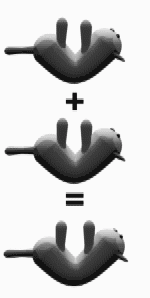


The cat righting reflex is a cat's innate ability to orient itself as it falls in order to land on its feet. The righting reflex begins to appear at 3–4 weeks of age, and is perfected at 6–9 weeks.[1] Cats are able to do this because they have an unusually flexible backbone and no functional clavicle (collarbone). The tail seems to help but cats without a tail also have this ability, since a cat mostly turns by moving its legs and twisting its spine in a certain sequence.[2]
While cats provide the most famous example of this reflex, they are not the only animal known to have a mid-air righting capability. Similar phenomenons have been observed in other small vertebrates such as rabbits,[3] rats,[4] lizards, as well as in certain invertebrate tailed anthropods (e.g. stick insects).[5]

After determining down from up visually or with their vestibular apparatus (in the inner ear), cats manage to twist themselves to face downward without changing their net angular momentum. They are able to accomplish this with these key steps:
Depending on the cat's flexibility and initial angular momentum, if any, the cat may need to perform steps two and three repeatedly to complete a full 180° rotation.[6][7][8]
In addition to the righting reflex, cats have other features that reduce damage from a fall. Their small size, light bone structure, and thick fur decrease their terminal velocity. While falling, a cat spreads out its body to increase drag.[9] An average-sized cat with its limbs extended achieves a terminal velocity of about 60 mph (97 km/h), around half that of an average-sized man, who reaches a terminal velocity of about 120 mph (190 km/h).[10] A 2003 study of feline high-rise syndrome found that cats "orient [their] limbs horizontally after achieving maximum velocity so that the impact is more evenly distributed throughout the body".[11]: 311
With their righting reflex, cats often land uninjured. However, this is not always the case, since cats can still break bones or die from extreme falls. In a 1987 study, published in the Journal of the American Veterinary Medical Association, of 132 cats that were brought into the New York Animal Medical Center after having fallen from buildings, it was found that injuries per cat increased positively with altitude until a height of seven stories, at which point injuries decreased. One cat fell 40 stories without injury, having apparently bounced off a canopy and into a planter.[12] The study's authors speculated that, after falling five storeys, the cats reached terminal velocity, at which point they relaxed and spread their bodies out to increase drag. However, critics of the study have questioned the conclusion that mortality rates decrease as height increases due to survivorship bias; falls that resulted in instant death were not included as a deceased cat would not be brought to a vet.[12] A 2003 study of 119 cats concluded that "Falls from the seventh or higher storeys, are associated with more severe injuries and with a higher incidence of thoracic trauma."[13]
{{cite book}}: CS1 maint: location missing publisher (link)